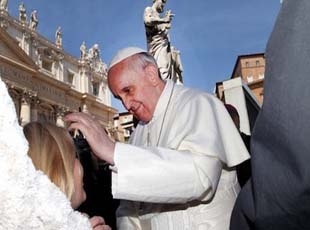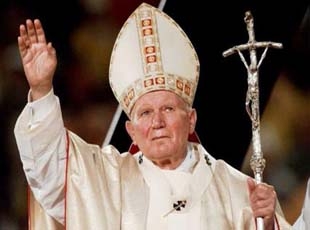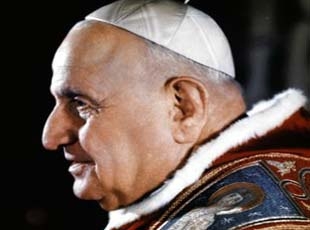Pope Francis clears sainthood for John Paul II, John XXIII
@@NEWS_SUBHEADLINE_BLOCK@@
 Vatican City, July 6: Pope Francis cleared the way Friday to declare Pope John Paul II, approving his second miracle attributed to his intercession while also issuing a rare decree that will bestow sainthood on Pope John XXIII. The moves represent a big-tent approach for the Roman Catholic Church by allowing pontiffs perceived to be from the church's right and left to be celebrated together.
Vatican City, July 6: Pope Francis cleared the way Friday to declare Pope John Paul II, approving his second miracle attributed to his intercession while also issuing a rare decree that will bestow sainthood on Pope John XXIII. The moves represent a big-tent approach for the Roman Catholic Church by allowing pontiffs perceived to be from the church's right and left to be celebrated together.
Pope Francis has confirmed a second miracle by Pope John Paul II, paving the way for sainthood before the end of the year, Rev. Federico Lombardi, a Vatican spokesman, said at a news conference.
In a major demonstration of his papal authority, Pope Francis decided to bestow sainthood on former Pope John XXIII. A Pope from 1958 to 1963 John XXIII opened the door in 1960 to sweeping changes leading to modernization of the Catholic Church.
It may be noted that Vatican requires two miracles for becoming a saint and Pope John XXIII doesn’t have a second miracle approved by the Vatican to his credit. But the Vatican maintained that Pope Francis has the power to circumvent the normal saint-making procedures to canonize him on his own merit, even without any miracle.
Father Lombardi said it is reasonable to expect the two men will be sainted on the same day, although cardinals must be summoned to a consistory to set the date, according to Vatican officials.
In another rare move, the pope issued his first encyclical—a document that typically sets the tone of a papacy—by relying largely on a text prepared by his retired predecessor Pope Benedict XVI.
The announcements come at a time of significant tensions and promised changes at the Vatican, offering emphatic backing both to modernization and globalization, represented by the Second Vatican Council launched by John XXIII and the tireless traveling of John Paul II, the first Polish pope.
Pope Francis, in one of his first remarks as pontiff, noted that cardinals had to go to "the end of the world" to find and choose him.
 John Paul II was elected in 1978 and died in 2005. His second miracle, now approved, is linked to a Costa Rican woman said to have recovered from a brain injury while praying during his 2011 beatification ceremony.
John Paul II was elected in 1978 and died in 2005. His second miracle, now approved, is linked to a Costa Rican woman said to have recovered from a brain injury while praying during his 2011 beatification ceremony.
The Spanish Catholic newspaper La Razon has indentified this woman as Floribeth Mora, and said she suffered from a cerebral aneurism that was explicably cured on May 1, 2011 the day of John Paul II’s beatification when 1.5 million people filled St Peter’s Square to honor the Polish pontiff.
His first involved a French nun who, like him, had Parkinson's disease. She was said to have been cured two months after John Paul II's death.
John XXIII reigned from 1958 to 1963, and was beatified in 2000, placing him at the doorstep of sainthood. A Vatican committee had voted in favor of his candidacy and Pope Francis has the power to waive the need for a second miracle, Father Lombardi said. The first involved a nun who had prayed to him and was cured of cancer.
For decades, the two popes have been held up as heroes of opposing schools of thought that emerged in the wake of World War II.
The Second Vatican Council introduced myriad changes to church teaching, allowing vernacular languages to replace Latin during Mass and embracing deeper dialogue with other faiths, in particular Judaism. Some liberal Catholics saw John XXIII as a champion of ecumenism and a flattener of hierarchy at a time of rapid social change.
 "The canonization of John XXIII is a response to the debate on and against Vatican II," said Alberto Melloni, a church historian and lead researcher on John XXIII's cause. "Francis canonizes in John XXIII the idea of renewal, poverty, unity and collegiality," the Wall Street Journal reported.
"The canonization of John XXIII is a response to the debate on and against Vatican II," said Alberto Melloni, a church historian and lead researcher on John XXIII's cause. "Francis canonizes in John XXIII the idea of renewal, poverty, unity and collegiality," the Wall Street Journal reported.
In the 1980s, John Paul II reined in many of those liberalizing impulses. He tapped Cardinal Joseph Ratzinger—the future Pope Benedict XVI and a leading theologian who participated in Vatican II—to reaffirm the place of traditional teachings in church doctrine, which bars Catholics from remarrying after a divorce, using artificial birth control and other secular practices.
A pope who stood up to Soviet Communism, John Paul II was greeted with cries of "Santo Subito!"—"sainthood now!"—during his funeral.
The decision to honor John Paul II a mere eight years after his death marks a stark break with church tradition, which usually requires decades, if not centuries, of reflection before canonizing someone.
His popularity, some Vatican analysts say, has long made him an ideal candidate to "accompany" more divisive sainthood causes, such as Pope Pius XII, the wartime pontiff accused of not doing enough to protect European Jews.
Popes have only rarely been canonized in the church's 2,000-year history. When they are, it is often done to reaffirm their teachings and legacy, according to Vatican analysts.
"They were truly fathers close to all the faithful," said Bishop Javier Echevarria, prelate of the conservative Opus Dei group, of the two candidates for sainthood. The decision means "millions of people feel like favored children."
Pope Francis on Friday also approved a miracle attributed to Álvaro del Portillo, a late leader of Opus Dei, paving the way for his beatification, which is one step away from sainthood.
Friday's encyclical, which repeatedly emphasizes that "faith is not a private matter," also in some ways underscores how Catholicism is one despite containing multiple strands, some said.
That it is a joint effort "is the church talking, and confirms the unity of the Church," said Cardinal Gerhard Müller, who is in charge of doctrinal matters at the Holy See.
Vatican officials acknowledged that it had been "almost completed" by Benedict XVI, whose resignation this year led to the current pontiff's election in March, but said Pope Francis had added his own "further contributions" to the "first draft."
"Lumen Fidei," or "The Light of Faith," caps a three-part series begun by Benedict XVI in 2005, exploring faith after prior tracts addressed love and hope, which together form the three theological virtues.
Beginning by recalling that even the pagan cult of the Sun God had arisen out of human hunger for light, the new encyclical expounds that faith is a kind of public good, one that individuals cannot engage in on their own but that liberates them from idols and offers them a truth beyond the notion of "subjective authenticity" that gathered strength in the wake of 20th century totalitarianism.
The 82-page tract notes that "no one baptizes themself" and devotes a whole chapter to evangelization and how believers cannot keep the gift of God's love for themselves.
It also asserts St. Paul's claim that faith comes from hearing, an activity Pope Francis has pursued on many fronts as he tries to wrestle down controversial practices and alleged lobbies inside the Roman Curia and at the so-called Vatican Bank.
True faith is humbling and leads to dialogue with science, other religions and nonbelievers, according to Lumen Fidei. "The certainty given by faith is a gift of grace, not grounds for arrogance," said Cardinal Marc Ouellet, the prefect of the Congregation of Bishops.
While Benedict XVI, the emeritus pope, triggered discord with what were perceived to be aggressive remarks about Islam in a speech he delivered in Germany, Francis took a fairly proactive stance on interfaith matters even when he was Archbishop of Buenos Aires, suggesting that in that area he shares much with the globe-trotting John Paul II.
Encyclicals aren't binding edicts but circular letters aimed at guiding discussion in parishes everywhere. While the latest one doesn't seek to innovate in the field of dogma, one of its key passages says the Second Vatican Council was "surely a council on faith."
That was widely seen as a forceful interjection by Pope Francis, a pastorally minded Argentine Jesuit, into what he described as the "fine work" of Benedict XVI, a sterner German sort.
Pope Francis' willingness to put his name on the document underscores how both he and his predecessor—who chatted Friday morning—are eager to see the papacy transformed from a personalist to an institutional role, said John Wauck, a professor of communications at the Pontifical University of the Holy Cross in Rome.
"There's a bit of a theory-and-practice dialectic," said John Wauck, a professor of communications at the Pontifical University of the Holy Cross in Rome. "There's a real one-two punch effect as Francis feels very comfortable quoting Benedict," he added.
"This text was written, so to speak, by the hands of two popes," said Msgr. Müller. But Cardinal Rino Fisichella, who heads the Holy See's evangelization department, emphasized that the document was signed by Francis alone and was a "very pastoral" text.
While Lumen Fidei is part of a Catholic tradition of warning against excessive reliance on science and technology, it also suggests that just as people trust architects and lawyers "who know better than we do" in their respective fields, so faith looks to Jesus Christ—and ideally also from his point of view—as a reliable expert "who makes God known to us."
(With additional inputs from Agencies)